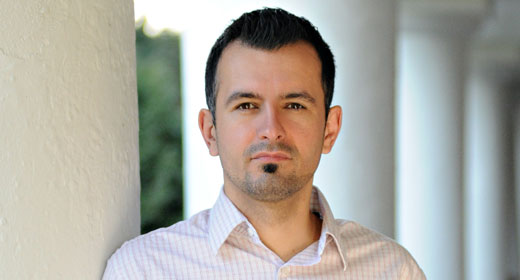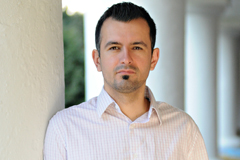
Instrument of Peace
 As a seventeen-year-old in the spring of 1992, Vladimir Bratic resembled many other young men his age. When he wasn’t in school, he could often be found playing basketball with friends or at home watching television or listening to the radio. Yet Bratic’s life was anything but typical. Sniper fire was almost as common as jump shots in those pick-up games, and for Bratic and his family, the media weren’t merely entertainment sources but also essential to their survival.
As a seventeen-year-old in the spring of 1992, Vladimir Bratic resembled many other young men his age. When he wasn’t in school, he could often be found playing basketball with friends or at home watching television or listening to the radio. Yet Bratic’s life was anything but typical. Sniper fire was almost as common as jump shots in those pick-up games, and for Bratic and his family, the media weren’t merely entertainment sources but also essential to their survival.
Recently promoted to associate professor of communication studies, Bratic was living in Sarajevo two decades ago when the war in Bosnia began. “The violence started in April 1992, but the cultural conflicts and structural inequalities had been with us for awhile,” he recalls. “We were at war before we realized we were at war.”
Bratic and his family lived in an apartment building originally constructed as part of the Olympic Village when Sarajevo hosted the 1984 Winter Games. When war came, Bratic says his family “continued to live life as if nothing’s happening. It’s hard for people to imagine who have never experienced it, but you have an amazing ability to adjust to not having food, electricity, or water.”
Bratic and his friends even dealt with danger. “We played basketball in a nearby school, and one day a grenade blew a huge hole in the gym. We couldn’t go there anymore, so we ripped out the basketball goal and put it in front of our building to keep playing. Every once in a while there’d be a sniper shot. You learned to recognize the sound of the bullets. At first you’d say, ‘The snipers are here, let’s not play,’ but then you’d get tired of reacting and just play on.”
Bratic and his family became increasingly dependent on the media for vital information about the conflict. “You can’t travel, the phone lines are cut, a lot of face-to-face communication is based on rumor, so you’re glued to the media to get credible news on everything from learning when aid might be coming to finding out whether you’re going to be shot at tomorrow.”
With unreliable electrical service, battery-powered radios usurped television as the primary media outlet. Bratic compares the situation to “the 1930s in the U.S. when everyone gathered around the radio. For us it became like a member of the family.”
The Bratic family’s radio was indispensable during one particularly harrowing night. “There was a broadcast claiming hordes of armed men were converging on our city, and I helped my father block the door of our apartment with the kitchen table. We were completely barricaded and our only connection to the outside world during the attack, our only way of getting details about what was happening, was this little radio. I realized media had the same importance as food and other basic needs. I thought, ‘I’d like to study this.’”
Bratic later enrolled at Palacky University in the Czech Republic, where he earned his bachelor’s degree, and then came to Ohio University, where he received a master’s degree in international relations and a Ph.D. in mass communication.
“At first, my studies dealt with propaganda and how the media can orchestrate a shift from loving one another to wanting to shoot one another,” he says. “But when the violence in Bosnia was finally resolved, many people concluded that if the media can motivate us to hate and kill one another, there must be something about it that can bring us together.”
Bratic interned with OBN, a television channel established by the international community to convey the benefits of the 1995 Dayton Peace Agreement to audiences in Bosnia. “I saw media could aid reconciliation, so I started studying that on both the master’s and Ph.D. levels.”
Bratic subsequently lectured and wrote journal articles about what he describes as a “four-pronged stool” of engaging the media as instruments of peace, one that involves “positive journalism, propeace messages in both entertainment and marketing, and using regulation to create an enabling environment for sustainable peace.” He caught the attention of the United States Institute of Peace (USIP), an independent, nonpartisan conflict management center established by Congress to moderate tensions throughout the world. “Collaborating with the USIP has given me the chance to see my research applied to real-life situations,” he says.
Bratic’s passion for peace building is matched by his dedication in the classroom. Since coming to Hollins in 2006, he has focused on enabling students to think critically. “I am gratified when students display intellectual curiosity. What I try to do is channel that into the problems that exist in the world. If I can connect their willingness to learn with all sides of a tough issue, that’s my biggest achievement. I’m setting them up to be critical learners for life.”
Bratic is researching a book that explores how new media that incorporate digital technology, and social media platforms such as Facebook, can contribute to the role of media in reconciliation. “I want to write this in a nonacademic, reader-friendly style that can be easily distributed. I’m disappointed in academic journal publishing—it puts work behind a firewall where few can access it. I want to get this to communities, to people who can use my writing if they teach or if they do something to inspire others.”
Vladimir Bratic received tenure and promotion to associate professor this year.
